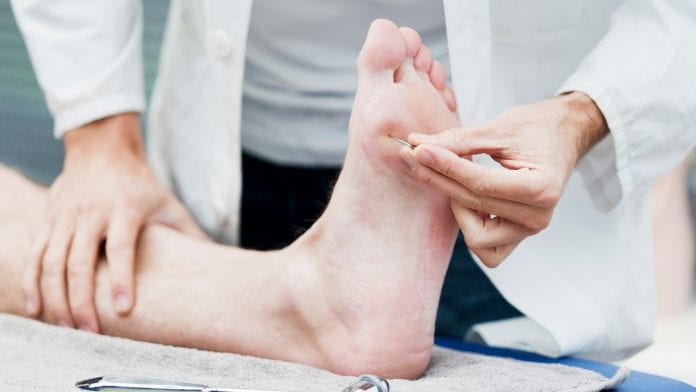
A new low-cost method, using 3D-printed structures, has been developed by scientists to help prevent diabetic foot ulcers.
Researchers from the Centre for Biomechanics and Rehabilitation Technologies (CRBT) at Staffordshire University have discovered a way to reliably detect the risk of foot ulcers developing, without the need for complex electronic in-shoe sensors.
A foot ulcer is an open wound or sore on the skin that is slow to heal and is common in people with diabetes. They can lead to other health complications, including amputations.
Dr Panagiotis Chatzistergos, Associate Professor in Orthopaedic Biomechanics, explained: “In the UK alone, 169 people have a toe, foot, or limb amputated as a result of diabetes every week, yet importantly up to 80% of these amputations could have been prevented with correct management.
“Routine overloading of the sole of the foot during daily activities can trigger the onset of foot ulcers, so being able to identify which areas in the sole of the foot are most affected is extremely important.”
Currently, a common method of detecting and treating foot ulcers involves assessing plantar pressure to prescribe special footwear or insoles. However, many clinicians cannot use this because it is expensive and difficult to use.
3D printed structures
Dr Chatzistergos and colleagues developed a novel concept which uses 3D-printed, tuneable structures to help clinicians better understand the cause of ulcer development and lead to improved patient outcomes.
Dr Chatzistergos, who led the study, said: “Our work has demonstrated a method to reliably detect overloading using a low-cost non-electronic technique. We have used a 3D-printed thin-wall structure that changes its properties when repeatedly loaded above or below a tuneable threshold. We believe that this is a step change from current practice.”
The concepts behind the work have been published in Royal Society Open Science.
Patients would be required to wear the sensor insoles in their everyday footwear for a representative time period, for example a day or a week, before returning them for analysis. During the analysis of the sensor-insole, plantar areas that were routinely subjected to higher pressures should be identifiable, against those where pressure was below that threshold.
Professor Nachi Chockalingam, Director for CRBT who co-authored the study, said: “Plantar pressure assessment is common amongst clinical practice and it contributes to insoles and footwear prescription. However, the current technologies are expensive and difficult to use in an everyday clinic.
“Each year more than 26 million people worldwide develop diabetic foot ulcers and the lifetime incidence of foot ulcers in developing countries is more than 20% among people with diabetes. Establishing low-cost methods to help prevent foot ulcers will reduce the global socioeconomic burden of diabetes and ultimately save lives. The concept reported within this paper, with further development, has the potential to transform clinical management of foot ulcer risk across the world.”






















